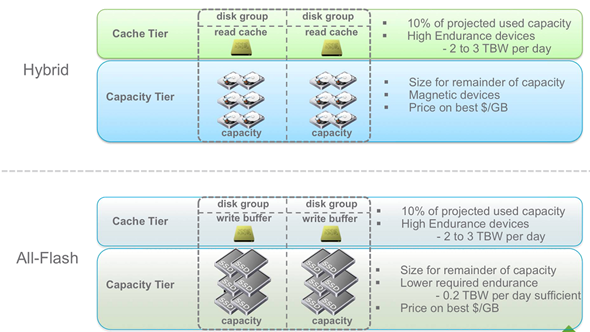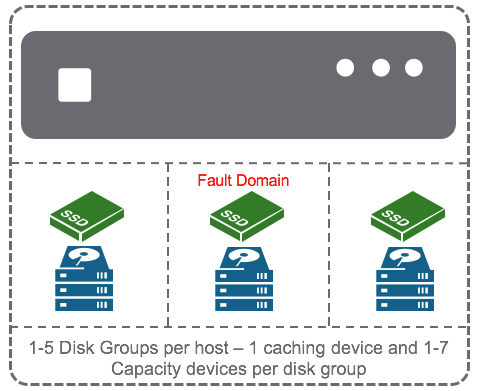VSAN Disk Group Test vSAN architecture consists of two tiers. This task is followed by the compression process.

One Versus Multiple Vsan Disk Groups Per Host Yellow Bricks
VSAN uses disk groups to make a single datastore.

. Disk groups compose the distributed flash tier and storage capacity of the Virtual SAN datastore. Disk Groups Design Background. All functional testing and validation of the design is on vSAN.
If you want to know more about how to Design Deploy and Optimize SQL Server on VMware and especially how to run SQL Server on VMware vSAN make sure to have a look on my webinar that Im running from May 7. This can be scaled up to five disk groups. However adding disk groups can be cost-prohibitive.
In hybrid clusters flash devices are used for the. As data is destaged the deduplication process will look for opportunities to deduplicate the 4KB blocks of data it finds within a disk group. Vmware vsan is a hypervisor-converged software-defined storage platform that is fully integrated with vmware vsphere.
1 800 GB NVME for the cache with PCIE 30. In hybrid clusters flash devices are used for the. In this post we will learn about what is disk group and what are limitations.
More disk groups increase space and provide higher availability. In the disk group the SSD primarily serves as a read cache write buffer while the HDDs are used for permanent storage. 2 rows Disk group sizing is an important factor during volume design.
Where disk groups from multiple esxi hosts in the vsan cluster makes the vsan datastore. Each disk group contains one cache drive which must be a flash-based storage device. All data on a disk group must be evacuated to other disk groups in the cluster before the reformat process can proceed.
Disk group is an logical container of multiple disks. A cache tier for the purpose of read caching and write buffering and a capacity tier for persistent storage. I hopethe above VSAN disk group design will work out.
Disk group 2. VSAN Physical Design for a Virtual Infrastructure Workload Domain This design uses VMware vSAN to implement software-defined storage as the primary storage type for the shared edge and workload cluster. The optimal number of disk groups is a balance between hardware and space requirements for the vSAN datastore.
The design uses the default storage policy to achieve redundancy and performance within the cluster. But if your Disk Controller suports the Passthrough Mode vSAN can also claim newly added disks automatically into a Disk Group. Each disk group must have one flash cache device and one or multiple capacity devices.
VMware vSAN Storage design includes conceptual design logical design network design cluster and disk group design and policy design. VSAN cluster devices are organized into disk groups. Otherwise it will leave as-is and continue destaging.
While a single capacity tier drive is the minimum requirement for a disk group for better performance when there are more VMs and better handling of rebuildresync activities we recommend configuring more than 1 capacity tier drive per caching tier. 5 2 TB SSD disks for capacity. If you read any other articles on my blog you will realise that I.
Typically a higher SSD to HDD ratio both in size and quantity improves performance. More available disk groups can increase the recoverability of vSAN during a failure. The devices used for caching cannot be shared across disk groups and cannot be used for other purposes.
If the 4KB block can be compressed by 50 or more it will do so. VSAN Conceptual Design and Logical Design This vSAN design is limited to the management cluster. VSAN cluster devices are organized into disk groups.
Capacity can be scaled up by adding devices to a host or scaled out by adding more hosts. A single caching device must be dedicated to a single disk group. VMware vSAN uses an aggregation of disk groups to create a single datastore when you enable vSAN.
The devices used for caching cannot be shared across disk groups and cannot be used for other purposes. The read-cache of a Disk-Group 70 of the SSD size is only so large and thus at any one time it can only contain a subset of all of the data in the Disk-Group - sure you could size the Disk-Groups so that the read-cache was the same size as cumulative capacity of the Capacity-tier but for most purposes this would be poor design and wasteful. By using vSAN you have a high level of control over the storage subsystem.
A converstation occured around the design and layout of the Disk Groups construct that. If more ESXi hosts are. All of the cache devices across the disk groups in every host is referred to as the cache tier.
I have gone through the vSAN 62 Design and Sizing Guide the vSAN 62 Network Design Guide and the vSAN 62 Stretched Cluster 2 Node Guide 230 pages and aggregated all of the design decisions design considerations and best practices into one page of bullet points that is easy to consume. A single caching device must be dedicated to a single disk group. This capability adds cost because additional hardware is required for the disk groups.
By default vSAN will ensure data is compliant with storage policies during the operation. If more ESXi hosts are available in a cluster more failures are tolerated in the cluster. VSAN Design Considerations Using Large Capacity Storage Devices Pete Koehler June 9 2020 vSAN and VMware Cloud Foundation environments powered by vSAN offer extraordinary flexibility in scaling.
A vSAN host with one disk group is supported but a common design recommendation calls for at least two disk groups. This two tier design offers supreme performance to VMs while ensuring that devices can have data written to them in the most efficient way possible. Vsan enables the rapid provisioning of storage within vmware vcenter as part of virtual.
Each disk group must have one flash cache device and one or multiple capacity devices. Disk group sizing is an important factor during the volume design. May I know what is the compatible Enterprise NVME and SSD disks for this R630 servers.
The number of disk groups can affect availability and performance. The number of capacity tier drives in a disk group has an impact of the performance of vSAN. When deduplication and compression or encryption are enabled or disabled vSAN performs a rolling reformat of each disk group.
The creation of a disk group requires the assignment of a single flash-based deviceSAS SATA or PCIe SSDand one or more magnetic disksSAS or SATA HDD. Vsan aggregates locally attached disks of hosts that are members of a vsphere cluster to create a distributed shared storage solution.

What Is Vmware Vsan Disk Group Esx Virtualization
Vmware Vsan Advanced Concepts 2 Virtualgyaan
Virtual Blocks Understanding Vsan Architecture Disk Groups
Virtual Blocks Understanding Vsan Architecture Disk Groups

Vsan Disk Groups Mastering Vmware

Vmware Vsan Design Guide Vmware

0 comments
Post a Comment